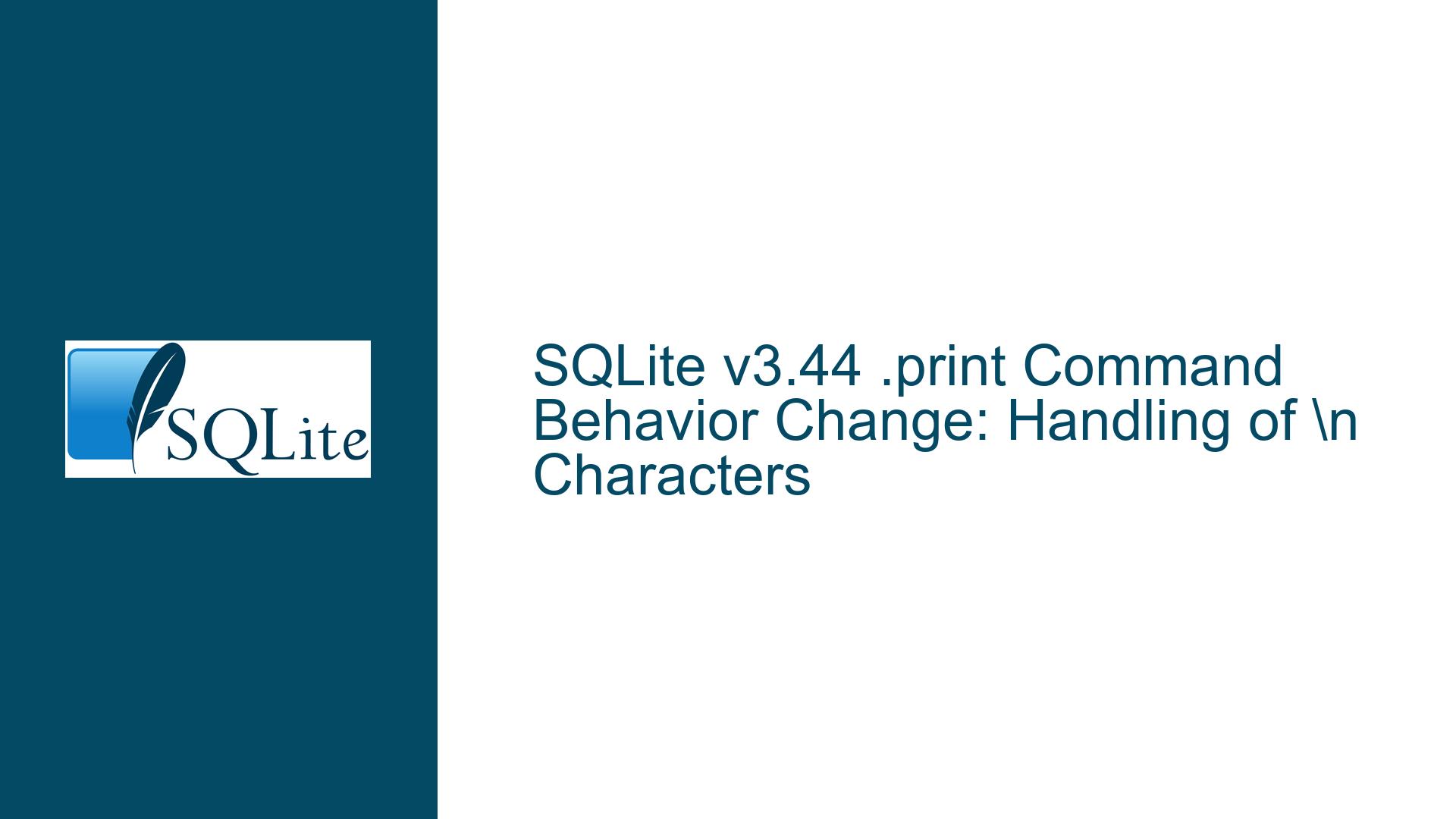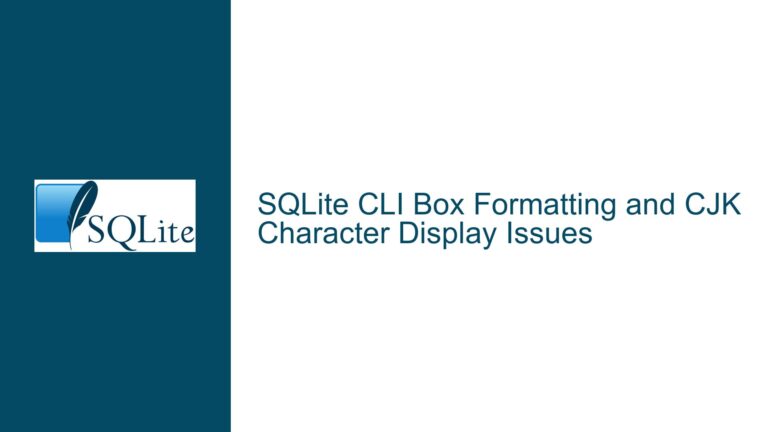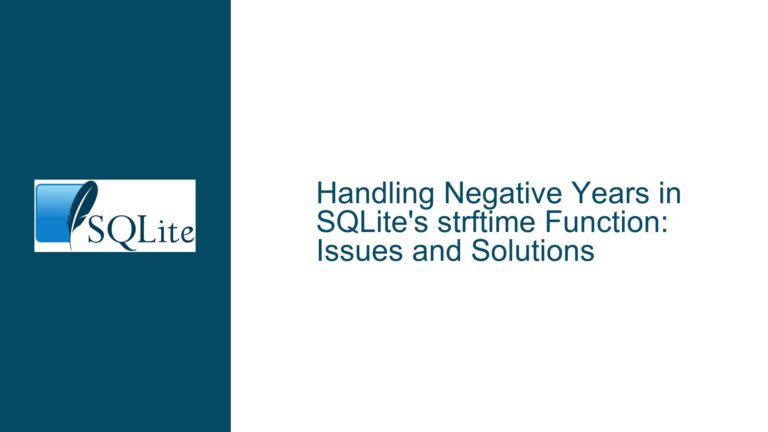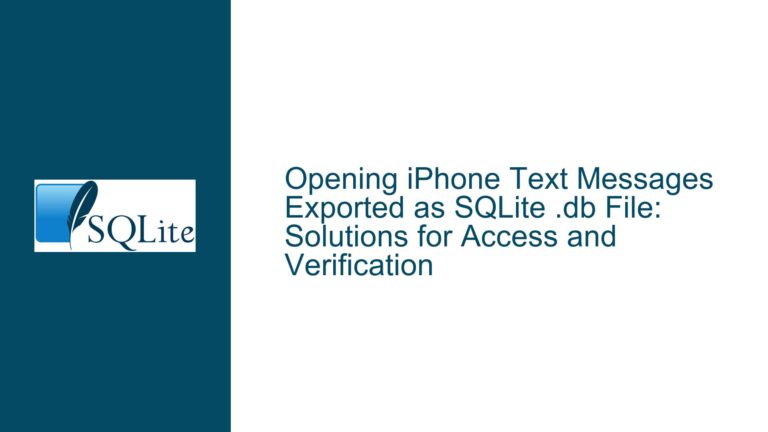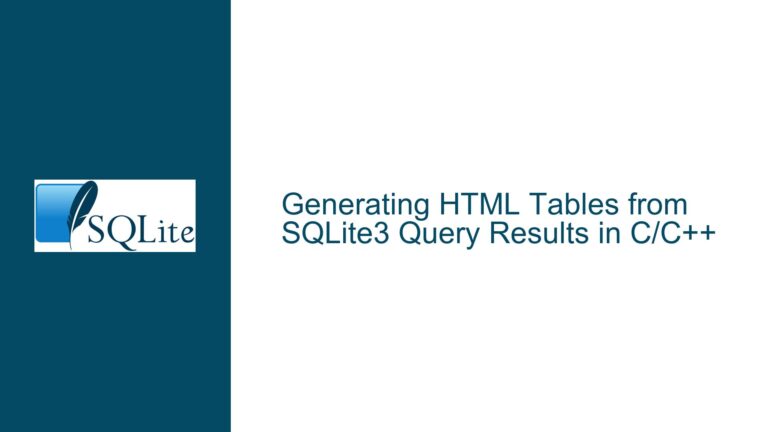SQLite v3.44 .print Command Behavior Change: Handling of \n Characters
Issue Overview: .print Command No Longer Recognizes Unquoted \n Characters in SQLite v3.44
In SQLite version 3.44, users have reported a change in the behavior of the .print command within the SQLite command-line shell (CLI). Specifically, the .print command no longer interprets unquoted \n characters as newline escape sequences. Instead, it treats them as literal text, resulting in the output of \n rather than a newline. For example, executing .print \nA\n in SQLite v3.44 outputs \nA\n as plain text, whereas in previous versions (e.g., v3.43.2), the same command would output a newline, followed by the character A, and then another newline.
This change has caused confusion among users who rely on the .print command for formatted output in scripts or debugging workflows. The behavior shift is particularly noticeable when upgrading from SQLite v3.43.2 or earlier to v3.44. Users who have not closely followed the CLI documentation or release notes may interpret this change as a bug, especially if their existing scripts or workflows depend on the previous behavior.
The issue stems from a deliberate change in how the SQLite CLI interprets unquoted arguments passed to the .print command. In SQLite v3.44, the CLI now strictly adheres to the documented behavior, which specifies that unquoted arguments are treated as literal text. This change was implemented to align the CLI’s behavior with its documentation and to address edge cases involving the use of backslashes (\) in file paths or other contexts.
Possible Causes: Why the .print Command Behavior Changed in SQLite v3.44
The change in the .print command’s behavior is not a bug but rather an intentional update to align the CLI’s functionality with its documentation. There are several reasons behind this change:
Documentation Compliance: The SQLite CLI documentation has long specified that unquoted arguments to the
.printcommand are treated as literal text. However, prior to v3.44, the CLI inconsistently interpreted unquoted\ncharacters as escape sequences for newlines. This inconsistency led to confusion and unintended behavior, especially for users who relied on the documented behavior. The update in v3.44 ensures that the CLI’s behavior matches the documentation, providing a more predictable and reliable experience.Path Separator Compatibility: One of the motivations for this change was to address issues arising from the use of backslashes (
\) as path separators in file paths. On some operating systems, particularly Windows, backslashes are commonly used in file paths (e.g.,C:\Users\Example). In previous versions of SQLite, unquoted backslashes in.printarguments could be misinterpreted as escape characters, leading to unexpected behavior. By treating unquoted arguments as literal text, SQLite v3.44 avoids this issue and ensures compatibility with file paths containing backslashes.Consistency with Other CLI Commands: The change also promotes consistency across the SQLite CLI. Many other CLI commands treat unquoted arguments as literal text, and the
.printcommand’s previous behavior was an outlier. By aligning the.printcommand with the behavior of other commands, SQLite v3.44 simplifies the CLI’s overall design and reduces the potential for confusion.User Feedback and Edge Cases: The SQLite development team received feedback from users who encountered edge cases where the previous behavior caused problems. For example, users who needed to print literal backslashes or other special characters found the old behavior cumbersome to work around. The change in v3.44 addresses these edge cases by providing a more straightforward and consistent approach to handling special characters.
Troubleshooting Steps, Solutions & Fixes: Adapting to the New .print Command Behavior in SQLite v3.44
If you have upgraded to SQLite v3.44 and are experiencing issues with the .print command, there are several steps you can take to adapt to the new behavior and ensure your scripts or workflows continue to function as expected.
Use Double-Quoted Arguments for Escape Sequences: The simplest and most effective solution is to use double-quoted arguments when you want the
.printcommand to interpret escape sequences like\n. For example, instead of.print \nA\n, use.print "\nA\n". This ensures that the CLI interprets the\ncharacters as newline escape sequences, producing the desired output. Double-quoted arguments are explicitly designed to handle escape sequences, making them the recommended approach for formatted output.Update Existing Scripts: If you have existing scripts or workflows that rely on the previous behavior of the
.printcommand, you will need to update them to use double-quoted arguments. This may involve modifying multiple.printcommands across your codebase. While this can be time-consuming, it ensures compatibility with SQLite v3.44 and future versions. Consider using a text editor or script to automate the process of adding double quotes around.printarguments.Review the CLI Documentation: Familiarize yourself with the SQLite CLI documentation, particularly the section on the
.printcommand. The documentation provides detailed information on how arguments are interpreted and highlights the differences between quoted and unquoted arguments. Understanding these nuances can help you avoid similar issues in the future and make the most of the CLI’s features.Test Your Code After Upgrading: Whenever you upgrade to a new version of SQLite, it is a good practice to thoroughly test your code to identify any changes in behavior. This is especially important for CLI commands like
.print, where subtle differences in argument handling can have a significant impact. By testing your code, you can catch issues early and make the necessary adjustments before they affect your workflows.Consider Using Alternative Commands: If the
.printcommand’s new behavior does not meet your needs, consider using alternative commands or techniques for generating formatted output. For example, you can use theSELECTstatement with thePRINTFfunction to produce formatted output directly from SQL queries. This approach provides greater flexibility and avoids the limitations of the.printcommand.Provide Feedback to the SQLite Development Team: If you encounter challenges or have suggestions for improving the
.printcommand or other CLI features, consider providing feedback to the SQLite development team. The team values user input and uses it to guide future updates and enhancements. You can submit feedback through the SQLite forum or other official channels.Stay Informed About Future Updates: The SQLite development team regularly releases updates that introduce new features, fix bugs, and improve performance. Staying informed about these updates can help you anticipate changes in behavior and adapt your workflows accordingly. Subscribe to the SQLite mailing list, follow the official blog, or monitor the release notes for the latest information.
By following these steps, you can effectively troubleshoot and resolve issues related to the .print command’s behavior in SQLite v3.44. While the change may require some adjustments, it ultimately contributes to a more consistent and reliable CLI experience.
